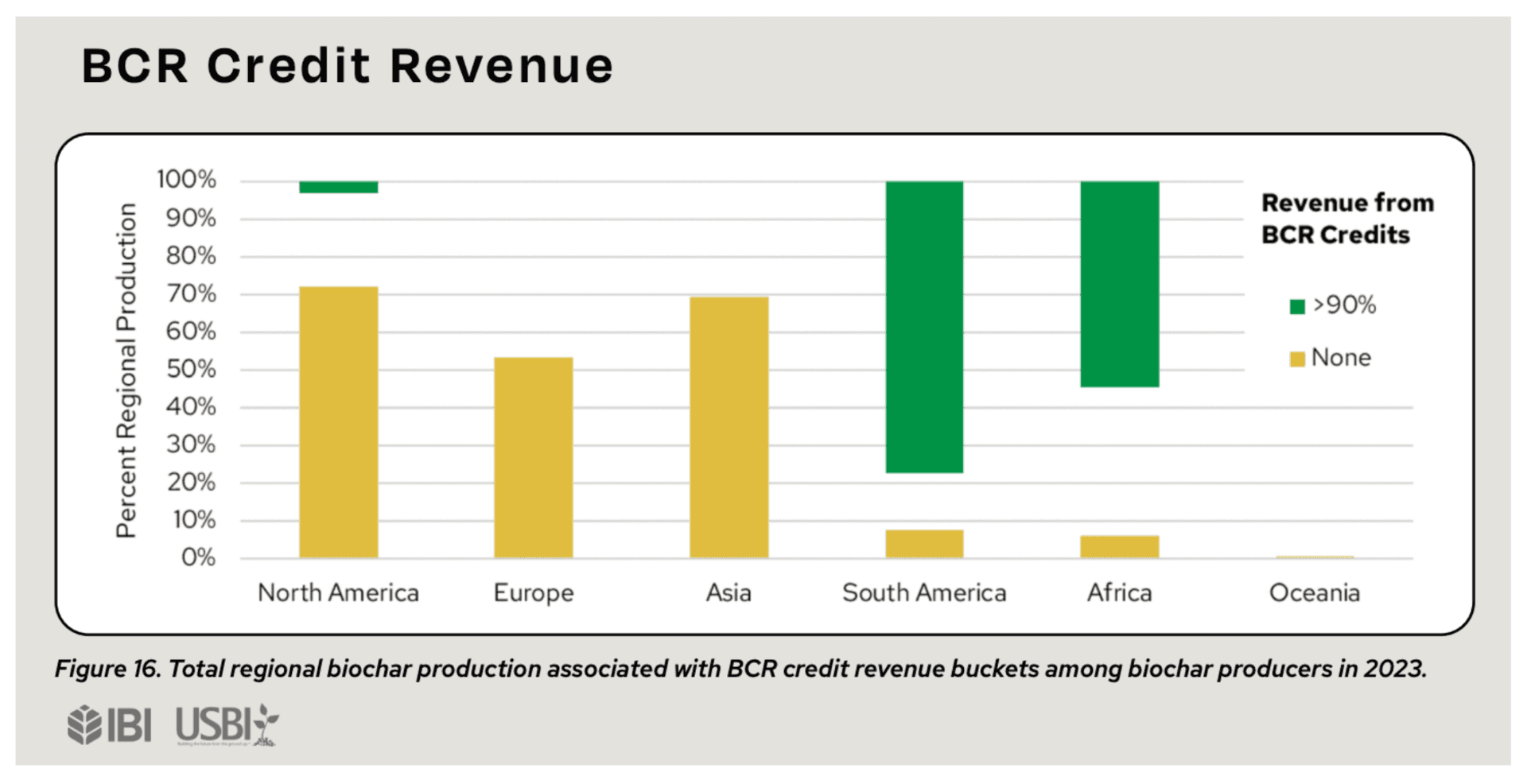March 29, 2024
The Global South Takes the Lead in Biochar Carbon Credits

In March 2024, the International Biochar Initiative (IBI) and the US Biochar Initiative (USBI) jointly published the 2023 Global Biochar Market Report, presenting comprehensive analyses of the global biochar industry’s status, growth, and challenges. The report is a fascinating read, and we applaud their efforts in putting together this invaluable resource for the industry.
According to the report based on a survey of biochar producers worldwide, North America leads in total production volume, followed by Europe, Asia, South America, Africa, and Oceania. The report states that global biochar production reached at least 352,304 metric tonnes in 2023, which equates to 650,000 metric tonnes of carbon dioxide removal (CDR), assuming an average of 1.9 metric tonnes of CO2 removed per metric ton of biochar.
Carbon Credits as a Revenue Stream
At CDR.fyi, we track the tonnage of carbon credits sold and delivered instead of what is produced. For clarity, some of that production is sold and not claimed as carbon credits. Our data shows 107,000 tonnes of biochar credits delivered in 2023. More than half of the surveyed producers, representing over 50% of reported global production, do not generate income from carbon credits. The report offers two potential explanations:
- First, it can be hard for small-scale producers to access carbon removal credits due to the associated costs of certifying their biochar production.
- Second, the biochar industry existed before carbon removal credits became a potential source of revenue for biochar producers. Pre-existing biochar producers could face a barrier in certifying their credits since what they are producing is not additional if credit income is not needed.
As a result, 52% of producers do not certify their physical biochar CDR, which is required to generate carbon credit. The IBI/USBI report points out that these companies can sell insetting to companies in their value chain (e.g., feedstock providers), though there is less visibility into these transactions.
Biochar Revenue Streams by Geographic Region
The report reveals a bimodal distribution: most producers in North America and Europe do not generate income from carbon credits or depend significantly on carbon credits as a source of revenue. Conversely, new facilities in Africa and South America often rely entirely on credit income.
Consequently, the Global South is emerging as a key source of growth in biochar carbon credits due to their lower overall production costs and their lack of reliance on the legacy revenue streams of their North American and European counterparts. This business model is often unavailable to previously producing North American and European producers because it does not meet the standard of additionality. As such, the sales of physical biochar account for most of their income.
Although the carbon removal market is a potential avenue to drive catalytic funding toward biochar projects, it remains difficult to access for established producers or a significant enough departure from their existing business model to represent too much of a risk to switch entirely. For these producers, business models combining both income streams are more likely to be successful in the long run.

Source: 2023 Global Biochar Market Report
The Growth of the Global South in Biochar Credits
As of March 28, 2024, 65 (or 78%) of the 83 suppliers of biochar carbon removal registered with CDR.fyi had sold carbon removal credits. Over 50% were based in Europe, 27% in North America, 8% in Asia, and 14% in continents predominantly South of the Equator.
Before 2023, North American and European producers dominated the biochar carbon removal market in tonnes sold and delivered. However, since the beginning of 2023, we’ve seen a marked increase in biochar carbon removal production from Global South countries. Looking at the locations of production (as opposed to the headquarters) of the top ten suppliers through the almost 15 months of 2023 and 2024 year to date (YTD), 6 out of 10 are based in the Global South.
For the full year of 2023, 29.2% of total biochar production came from the 6 of these 10 companies with production locations in the Global South. In 2024 YTD, with the first quarter not yet fully closed, it has been 75.6%.
Three suppliers that emerged since Q4 2023, all based in the Global South, represented 42.9% of total biochar credits sold since 2023:
- Exomad Green, the leader in both sold and delivered tonnes from biochar, is based in Bolivia. They recently announced the second-biggest sale of 81,600 biochar credits to Senken.
- The Next 150 from Mexico, is the second biggest seller. They recently sold 95,000 tonnes to Microsoft, the largest biochar deal to date, as well as 22,500 tonnes to Shell Environmental Products.
- Bio-Logical, a supplier from Kenya, had also sold 10,000 tonnes to Microsoft in February, 2024.
These deals also show an interesting trend with larger biochar purchases emerging. Less than 10% of biochar deals are of purchases over 1000 tonnes, while 64.6% are under 100 tonnes. All top 10 biochar carbon removal purchasers have purchased an accumulated amount of over 6000 tonnes.
With Q1 2024 not yet closed, biochar sales are already 60% of the entire year of 2023, portending continued strong growth for full-year 2024. And with 74.5% of all-time durable CDR deliveries coming from biochar carbon removals, purchasers may see it as a shovel-ready way of investing in durable carbon removal.
A post by: Robert Höglund. Data and charts by Tank Chen. Contributions from Alex Rink.